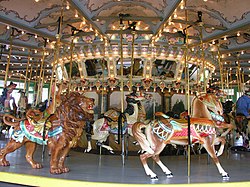Glen Echo Park, Maryland
|
Glen Echo Park Historic District
|
|
 |
|
| Location | 7300 MacArthur Blvd., Glen Echo, Maryland |
|---|---|
| Coordinates | 38°57′59″N 77°8′17″W / 38.96639°N 77.13806°WCoordinates: 38°57′59″N 77°8′17″W / 38.96639°N 77.13806°W |
| Area | 9 acres (3.6 ha) |
| Built | 1891 |
| Architect | Multiple |
| Architectural style | Moderne, Queen Anne, Shingle Style, Spanish Colonial Mission Revival |
| NRHP Reference # | 84001850 |
| Added to NRHP | June 8, 1984 |
|
Carousel at Glen Echo Park
|
|

Animals on the carousel
|
|
| Location | MacArthur Blvd., Glen Echo, Maryland |
|---|---|
| Area | less than one acre |
| Built | 1921 |
| Architect | Dentzel, Gustav; Dentzel, William |
| NRHP Reference # | 80000351 |
| Added to NRHP | July 4, 1980 |
Glen Echo Park is an arts and cultural center located in Glen Echo, Maryland that, in its former incarnation, was a popular Washington, D.C.-area amusement park that operated for several decades from the early 1900s to the 1960s. The arts and cultural center takes its name from the amusement park.
Located roughly nine miles northwest from downtown Washington, D.C., the site of Glen Echo Park was originally conceived and developed as a National Chautauqua Assembly in 1891. Following the foreclosure and sale of the Chautauqua grounds in 1903, leisure facilities were then developed for the growing population of Washington, D.C. In 1911, the site was significantly expanded to become Glen Echo Amusement Park, which operated continuously until its closure in 1968.
Today Glen Echo Park is one of the more important cultural resources in the Washington, D.C. area, offering hundreds of classes, workshops and performances in the visual and performing arts. The facility is well known for its Art Deco architecture, an antique Dentzel carousel, a historic Spanish Ballroom, as well as its children's theaters, social dance programs, and many public festivals, including Family Day and the Washington Folk Festival. Each year more than 400,000 people attend events and participate in instructional activities at the park. The National Park Service also offers park history tours and maintains a visitors area.
Edwin and Edward Baltzley, inventors, industrialists, and real estate developers, hoped to build upon the banks of the Potomac River a suburban community free of the urban pollution of late-nineteenth century Washington. In order to compete with other suburban developments, the Baltzley brothers planned a series of opulent attractions for their would-be community.
On February 24, 1891, the Baltzley brothers incorporated the National Chautauqua of Glen Echo, the 53rd such assembly, and immediately set to building a stone citadel of culture to complement their real estate and resort enterprises. Opened on June 16, 1891, their arts and culture program included lectures and concerts in a six-thousand-seat amphitheater; special classes in Bible studies, Greek, and Hebrew; physical training regimens; and university extension courses. Hundreds flocked to the site to picnic, attend lectures on American history by Jane Meade Welch, courses on ancient Egypt by Lysander Dickerman, and concerts by John Philip Sousa and his band.Clara Barton, encouraged by the Baltzleys, not only located her home and the American Red Cross headquarters at Glen Echo, but she presided over the Women’s Executive Committee for the Chautauqua itself. The inaugural season’s success warranted an extension well into August.
...
Wikipedia


